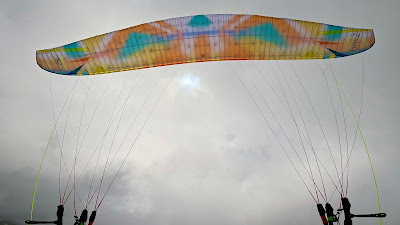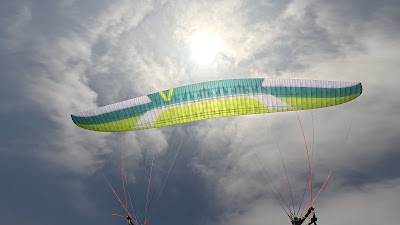Disclaimer:
Please note again… that tests will always differ with other sizes. At first, if flown with seatless harnesses, or must I say a completely different harness. Also if the same sizes are flown at different loads, lighter loads will get the weakest climb but will be penalized in control in heavy air or pushing through a heavy airmass. Bigger sizes have more gliding performance and also better climb in weak conditions. In my small tests, I always state the size, the total flying weight, and afterward IMHO, the optimum weight I found in that particular glider.
NOVA Mentor 7 S / 80-105
After my test flight of the Light Mentor 7 in XS size, I decided to get the bigger size in a normal and sturdy cloth.
NOVA uses my favorite cloth on this version which is on the top surface a mix of Skytex 38 Universal 38g/m², and Skytex 40 Eazyfly 40g/m² and on the lower surface the Skytex 40 Eazyfly 40g/m². They have indeed a different crispy feel of their own.
Having flown all the Mentors for the very first editions, my head was stuck on that idea to fly at the top, but…
After my test on the light XS, and NOVA's recommendation to fly it near the middleweight, I have decided to fly the S size which goes to 105 weight extended at 96, 97. Later, I found that this is indeed the sweet spot in the Mentor 7 series. There seem to be nowadays more and more new creations that are quite nice to fly at the middle range, like the PHI Maestro 2 for example that could be flown less than 6 kg from the top easily. Now the Mentor 7 S has its sweet spot less than 10 kg from the top!. You could, of course, fly it easily near the top when you need speed on generous days for winning competitions.
Launching the normal Mentor 7 is as easy as the light version. It inflates quite well, without any hard points, and the take is immediate.
As you probably read my notice at the top of the test, different sizes and different loads, and also lighter materials may give another feel… And sometimes they differ a lot!
I can say that I am very lucky to fly as many gliders to experience those small and sometimes big changes and feel those differences.
The Mentor 7 S at 97 feels slightly more subtle and sweeter to fly than the XS 75-95 light, even when flying it at 87. The movements are very similar to the light XS ones but with a touch of some nicer spices! It is the most comfortable high B glider to fly in rowdy air, but not dull to fly! It gives slightly more feel to interpret calmly the airmass than the light version. For me the small added spices probably came from the harder cloth and the bigger size…made the glider incredibly balanced and nicer to fly for the pilot underneath it.
Even the brake inputs are crispier than the light version, they are as short to react and very direct a bit more precise than the XS size. I was happily flying it in thermals. The Mentor 7 S doesn’t communicate as much as the Maestro 2. All the movements are calmer and more gentle. It is possible That you can drink sometimes a cup of coffee while coring without spilling it! And you will see yourself higher at the same time…
In weak thermals climbing next to my reference high B, I think the Mentor 7 S climbs as well and never loses that small weak thermal. It floats nicely.
The pitch is nearly absent and the roll is very dampened. It just climbs without bumping in thermals. A smoother glider in turbulence with very high efficiency! At 97 all up, I sensed a moderate trim speed versus the Maestro 2 but without any consequences for efficient gliding through the air. When I felt that I needed to push the speed bar, the glide was impressive!
And I always found myself quite competitive in the high B class, and even with the class above but with a touch slower!
While doing this test, even my head never stopped asking me that question: If a pilot is not competing in the C class, why would he be flying anything else? And then came answers…Perhaps more agility? brake feel? price? more feedback? design and color? brand oriented? Lots of possible parameters to consider…. one thing is for sure: The very high (comfort and performance package) found on the Mentor 7 is very rare.
Pushing on the speed bar has moderate pressure on the X-rated6, and I saw 15 km/h over trim at 800 ASL. The glide at max speed is as efficient as my reference in the high B category. The C steering has a moderate pressure and it is an efficient tool to control the already stable M7 above your head in turbulent air while on the speed bar.
Ears with outer B’s is easy and efficient and reopens quickly.
Some pilots will ask me about the performance differences with the 2 liners C category. It comes always about the pilot skills.
Example 1 in a regular XC flight: Pilot A with lots of experience on the Mentor 7 versus a good pilot B with moderate experience on the new 2-liner C’s. My answer would be: Pilot A would ‘probably’ fly further.
Example 2 in competition: Same pilot A with lots of experience on the Mentor 7 versus a good pilot B with moderate experience on the new 2 liner C’s. My answer would be that if pilot A can hold the speed bar +35 % of the time over pilot B, then there’s perhaps a tie possibility…
It is just to give you a little idea.
Conclusion:
This regular version of the mentor 7 in S size felt quite good.
Climb and glide are excellent, and handling, agility, and brake coordination are quite acceptable. Comfort is very high without being too dull and sometimes quite appreciated in high turbulence. The top speed is good and usable in active air. The Mentor 7 S… ( Bentley of the sky)
















